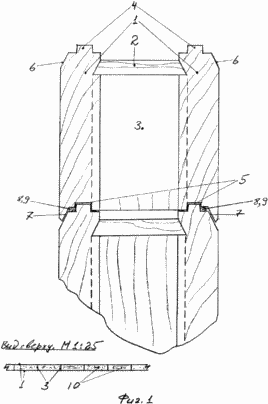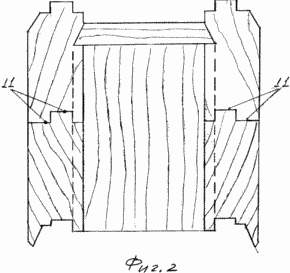| Start of section
Production, amateur Radio amateurs Aircraft model, rocket-model Useful, entertaining |
Stealth Master
Electronics Physics Technologies Inventions |
Secrets of the cosmos
Secrets of the Earth Secrets of the Ocean Tricks Map of section |
|
| Use of the site materials is allowed subject to the link (for websites - hyperlinks) | |||
Navigation: => |
Home / Patent catalog / Catalog section / Back / |
|
INVENTION
Patent of the Russian Federation RU2280741
![]()
PROFILED GLUED WOODEN BAR
The name of the inventor: Konstantin Dmitrievich Suvorkin (RU); Kurchakov Yuri Konstantinovich
The name of the patent holder: Svorkin Konstantin Dmitrievich (RU); Kurchakov Yuri Konstantinovich
Address for correspondence: 143083, Moscow region., Odintsovo rn, pos. Sanatorium Barvikha, 10, ap. 18, K.D. Suvorkin
Date of commencement of the patent: 2004.09.29
The invention relates to the field of construction, in particular, to long-dimension building structures made of wood, and is used as elements protecting and bearing wall and similar structures. The technical result of the invention consists in the production of a wooden beam on the side surfaces of which no cracks are formed, which is less prone to bending and torsion upon drying, easier and more technological in manufacturing and drying, and less material-intensive than existing ones. The glazed wood plate is made of 2 longitudinal plates arranged in parallel at a distance from each other, rigidly fastened together along the entire length by the third longitudinal plate, the plane of which is perpendicular to the planes of the fastened plates, and transverse plates whose planes are perpendicular to the planes of the longitudinal plates .
DESCRIPTION OF THE INVENTION
A profiled beam of solid wood is widely used in the construction of wooden buildings (Handbook on sawmill., M., 1991. P. 15. See GOST 18288-87, Sawmill Production, pp. 3-5). The main disadvantage is the formation of cracks on the outer surface, curvature and torsion of the beam, caused by uneven shrinkage deformations when the wood dries. Drying of a solid beam presents a rather complicated and expensive task, because The complexity of drying the wooden element and the formation of shrinkage cracks on the surface increase disproportionately with increasing thickness.
As a prototype, we choose a glade-shaped profiled bar consisting of several boards glued along the plane (Patent RU 2168594 C1, E 04 C 3/14, 10.06.2001). The main drawback of this bar is the high cost caused by the complexity of manufacturing:
1. The need for finishing a large number of surfaces (8-m excluding the outer for a 5-ply timber) to perform high-quality gluing planks among themselves.
2. The need to use presses of high power for tight pressing each other sufficiently thick (30-40 mm) boards.
3. The need to dry a large number of boards (5 pieces for a 5-layer beam).
Both of the above bars require a wood consumption equal to the volume of the bar, and have a corresponding weight.
The technical object of the present invention is to eliminate the above disadvantages and to produce a wooden beam that is sufficiently technological in manufacture, on the side surfaces of which no cracks are formed, less prone to bending and torsional drying, more light and less material-intensive.
This task is achieved due to the fact that the glazed wood plate, consisting of glued together plates, is made of 2 longitudinal plates arranged in parallel at a distance from each other, rigidly fastened together along the entire length of the third longitudinal plate, the plane of which Is located perpendicular to the planes of the fastened plates, and transverse plates whose planes are perpendicular to the planes of the longitudinal plates.
The construction of the beam is illustrated in the drawings, where FIG. 1 is a cross-section of 2 beams and a plan view, FIG. 2 is a cross-section of the beams connected to the glue. FIG.
 |
 |
Plates 1 (boards or planks) arranged in parallel at a distance from each other are fastened along the entire length by a plate 2 (a board or a bar), the plane of which is perpendicular to the planes of the plates 1, and transverse plates 3 (short boards or bars), the planes of which are perpendicular to the planes Longitudinal plates, located at a certain distance from each other.
The fastening plate 2 may be located at the top or bottom of the bar. The fastening of the plates is carried out on the glue and can be strengthened by insets, screws and other known methods.
In the longitudinal plates 1, protrusions 4 and their reciprocal slots 5, inclined faces 6 for draining the water and their counter faces 7 closing the joint between the lower and upper beams, and the cavities 8 between the upper and lower bars for placing the warming cord 9 can be made.
The heating cord 9 can be made breathable from moss, tow, hemp and the like, or hermetic of polyurethane foam, foam and the like.
In the cavities between the longitudinal plates 1 and 3 can be a heater 10 made of a porous light material such as mineral wool, foam.
This bar design has sufficient spatial rigidity. When assembling the wall from the beams, the rigidity of each beam and the wall as a whole is further increased by fixing the protrusions of the four underlying beams in the reciprocal grooves of the 5 overlying bars.
Longitudinal plates 1 can be made of not less than 2 glued-wood logs fastened together by the upper and the reciprocal lower edges of the adhesive layer 11 (FIG. 2).
Kleederevyananny bar can be made of several beams, fastened together on the ends of the glued joint "on the spike."
CLAIM
1. Kleyderevyanny profiled bar, consisting of glued together plates, characterized in that the bar is made of 2 longitudinal plates, located in parallel at a distance from each other, rigidly fastened together along the entire length of the 3rd longitudinal plate, the plane of which is perpendicular to the planes Fastened plates, and transverse plates whose planes are perpendicular to the planes of the longitudinal plates.
2. Kleederevyanny profiled bar according to claim 1, characterized in that the longitudinal plates are made of at least 2 kleederevyanannyh bars, fastened together on the upper and the lower edges responding to them with an adhesive layer.
print version
Date of publication 01/21/2007




Comments
When commenting on, remember that the content and tone of your message can hurt the feelings of real people, show respect and tolerance to your interlocutors even if you do not share their opinion, your behavior in the conditions of freedom of expression and anonymity provided by the Internet, changes Not only virtual, but also the real world. All comments are hidden from the index, spam is controlled.